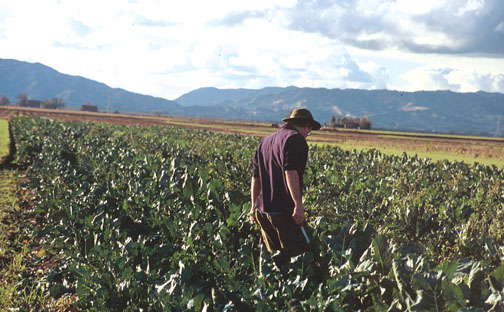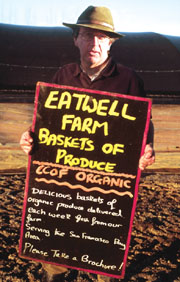Come late March, the Ferry Building; San Francisco civic symbol, original home to the Port and keystone of the regional waterfront, will bustle with life and commerce again after years of restoration work. The new Ferry Building has attracted San Franciscoís Farmerís Market, which plans to move there in time for the opening. We wanted to learn more about this waterfront feature attraction, so this month, in a specially expanded version of Working Waterfront, we visit with a Farmerís Market stalwart Nigel Walker, co-proprietor of Eatwell Farms.

Published: January, 2003
Since coming under the capable wing of the Center for Urban Education about Sustainable Agriculture (or, as it’s more digestibly known, CUESA), San Francisco’s Farmers’ Market is a thriving success story. Boasting a celebrity Board of Directors (Alice Waters of Chez Panisse, for one), dedicated staff, and a large and loyal following of customers, the Market, which takes place Tuesdays at Justin Herman Plaza (foot of Market) and Saturdays at Embarcadero and Green Streets, is a hit with gourmands and the general public alike.
And it appears that good fortune is not through smiling on CUESA. Thanks to the munificence of Chris and Michelle Meany, developers of the Ferry Building renovation project, the Farmers’ Market is about to take up residence in what is perhaps San Francisco’s most recognizable downtown landmark.
As we gear up for the anticipated late-March opening of the Ferry Building, Bay Crossings visited with Nigel Walker, co-proprietor of Eatwell Farms, one of the farmers who make up the Farmers’ Market, for a specially expanded Working Waterfront feature.
My partner, Frances Andrews, and I have been farming ten years now in the Bay Area. About five years ago now, we were lucky enough to be able to buy some land, about 65 acres.
I’m 41 and went to agricultural college in England. I was farming in England before I was farming here, so I’ve actually been farming 21 years. Before I was a farmer, I worked for the BBC in London, for the World Service as a radio studio engineer. I thought, it’s okay, but I’d like to try something else for a while. So I’ve been trying farming ever since.
Then I came to have a look around here in the States and then I met Frances. So, the rest is history.
We’re in Solano County, about four miles north of the town of Dixon. It’s dead flat, laser-level flat.
We have four full-time people. I think one day there were 17 people working on the farm.
We pick for the market 50 weeks of the year and we’re planting every week of the year, too. In the first few weeks of the New Year, we’ll be starting to sow the tomatoes for next summer.
The three big crops we grow are lavender, sunflowers, and heirloom tomatoes. We also have about 12 acres of fruit trees and we grow lots of vegetables, anything from basil in the summer, melons, and butternut squash. And in the winter we grow lettuces, cabbages, cauliflower, and broccoli. So we grow way too many things.
BC: Now, let’s talk about these farmers’ markets. We’re going to be talking about the one in San Francisco in a moment. But how many do you participate in?
We don’t just appear at the San Francisco Farmers’ Market. During the peak summer months, we can be doing five markets a week. We do the Saturday Ferry Plaza year-round along with the Tuesday Market down by the Hyatt at Justin Herman Plaza, which we do from about May until it really starts to rain. Dried lavender and things like that don’t hold up well when it’s pouring rain. The other markets we do in the summer period are the Sunday Marin Market, over by the Civic Center; the Saturday Market at the Grand Lake in Oakland; and we also did the St. Helena Market on Friday this last year.
Altogether, the Farmers’ Markets account for about 40 percent of our income. About half of the rest comes from the approximately 250 baskets that we deliver to locations around the Bay Area. We deliver what’s seasonal; in the summer, we’ve got all our peaches, nectarines. In fact, the people at Farmers’ Markets don’t see that we grow so much fruit. We only grow it for our baskets.
The rest of our income comes from selling our specialty heirloom tomatoes and sunflowers to Rainbow Grocery and Cal-Mart in Laurel Heights in San Francisco and Monterey Market in Berkeley.
It’s a labor of love. But you know, it’s not just farmers that work ridiculous hours; many architects and accountants and lawyers and teachers do the same. If you’re asking me if I make pots of money, well, it’s our only source of income, so we have to make a profit and we’ve managed to do that nine years out of the last ten. We’ve managed to scrape by.
And we think things will get even better once the Farmers’ Market moves to the Ferry Building because it’s got better public transportation. By the Ferry Building, we have BART, Muni, other buses, trams, and the ferry.
The location of the market at the moment is a little difficult for some people to get to. When we were at the Ferry Building before, we had people coming from Oakland and Sausalito, all on the ferry. I would see them leave the market with bags full of stuff and go right across to the ferry. I think we’ve lost some of those customers because we moved. I look forward to seeing them again!



